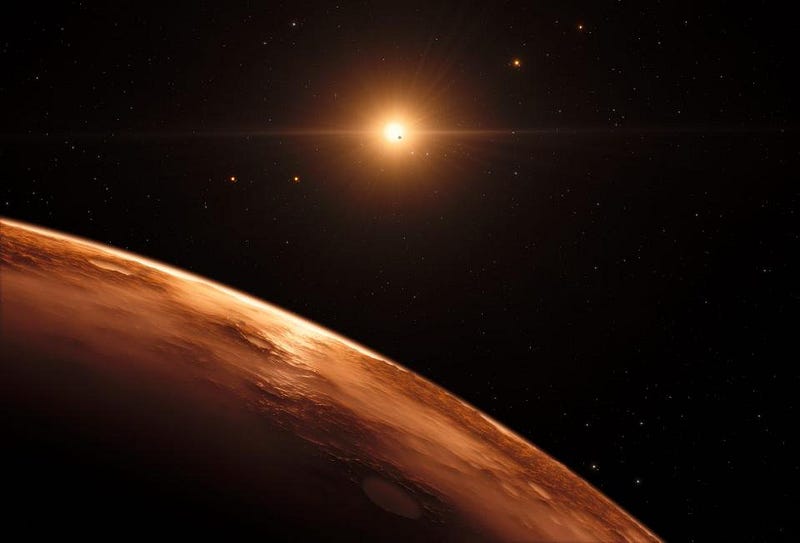Seven planets, including three habitable ones, found around ultra-cool dwarf star

But are any of these potentially Earth-like worlds actually inhabited? Here are the prospects.
“It isn’t only the beauty of the night sky that thrills me. It’s the sense I have that some of those points of light are the home stars of beings not so different from us, daily cares and all. who look across space with wonder, just as we do.” –Frank Drake
Forty light-years away, a faint, dim, tiny star known as TRAPPIST-1 caught the fancy of a team of exoplanet hunters led by Michaël Gillon. By observing the starlight over long periods of time, they could tell when an orbiting planet passed in front of it, blocking a small fraction of its light in a periodic fashion. Only a small fraction of stars have their planets aligned in such a way that we can see them, and even fewer have rocky, Earth-like worlds at the right distance to potentially have liquid water — and life as we know it — on them. But this particular star, as scientist Brian Koberlein reports, was discovered to have seven planets orbiting it. Not only that, but three of them might be perfect for life.

In order to be habitable, at least habitable like Earth is, a world needs to be:
- at the right distance from its star,
- of the right mass,
- with the right atmosphere,
- and with the right amount of liquid water on its surface.
While Earth is 150 million kilometers (93 million miles) away from the Sun, TRAPPIST-1 is only 8% the mass of the Sun, and gives off only 0.05% of the Sun’s energy. It would take more than 1900 stars like TRAPPIST-1 to equal the Sun.

Yet at the same time, the seven worlds discovered to orbit TRAPPIST-1 are incredibly close in. They’re more comparable to the moons of Jupiter than they are to the planets in our Solar System as far as distances go. Yet that’s exactly what this system would need if it were to have any hope of liquid water on one of its worlds. As coauthor Amaury Triaud explains:
The energy output from dwarf stars like TRAPPIST-1 is much weaker than that of our Sun. Planets would need to be in far closer orbits than we see in the Solar System if there is to be surface water. Fortunately, it seems that this kind of compact configuration is just what we see around TRAPPIST-1!

The way we reconstruct how large each planet is comes from noticing how much light is blocked when it transits in front of the star. Seven unique, periodic signals were identified, with each one corresponding to a bona fide planet.

Remarkably, each one of them is approximately the size of a world like ours, with many of them right around the size of Earth or Venus. They’re almost perfect: massive enough to hold onto a reasonably thick atmosphere, yet small enough to still be rocky, without a gaseous envelope.

Unlike the worlds in our Solar System, each one should be tidally locked to the parent star, meaning that the same side always sees “day” while the opposite side resides in eternal night. Yet life on Earth began in the oceans, and of these seven worlds, the fourth, fifth and sixth might all have conditions to support liquid oceans or lakes — if the atmosphere is favorable — bathed in eternal sunlight.

These worlds are also interesting because they’re substantially different from the worlds in our Solar System in some ways: they’re only about two-thirds as dense. While other solar systems we’ve found, mostly around more massive stars than TRAPPIST-1, have most of their worlds substantially smaller or larger than Earth, this system has seven worlds that are all approximately our size. As Michaël Gillon notes:
This is an amazing planetary system — not only because we have found so many planets, but because they are all surprisingly similar in size to the Earth!

This is a record-breaking system, beating even our own, for the number of Earth-sized worlds and the number of potentially habitable worlds that may have liquid water on their surface. In addition, there may be additional, larger planets farther out, that either aren’t transiting this star or transiting it enough times to have been detected yet. Future observations may yet reveal more than eight planets meeting the International Astronomical Union’s criteria, which would make TRAPPIST-1 the richest star system ever found.

While the discovery of these seven planets is remarkable, the most interesting part of this story is yet to be written. As our telescopes become larger and more sophisticated, we’ll finally gain the ability to measure the spectra of these worlds’ atmospheres, search for signs of water and life, and perhaps even discover an answer to whether we’re not alone in the Universe as far as life goes. With three strong candidates, we might finally need to face the possibility that most of the life that arises in the Universe might occur around stars that aren’t like the Sun!
This post first appeared at Forbes, and is brought to you ad-free by our Patreon supporters. Comment on our forum, & buy our first book: Beyond The Galaxy!





